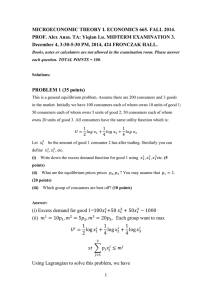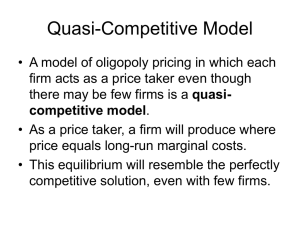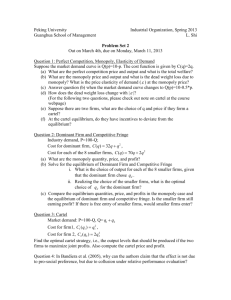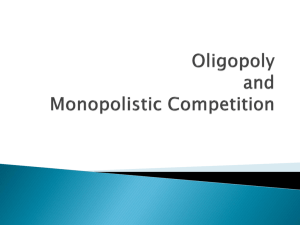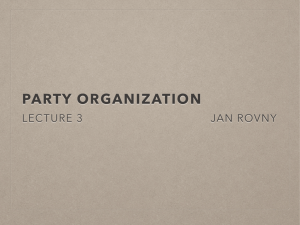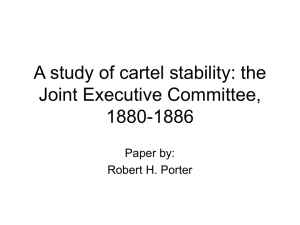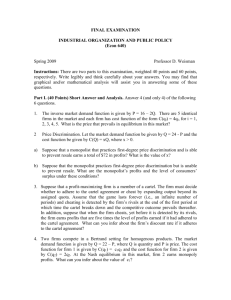For Publication on the Authors’ Web Page 1) Data
advertisement
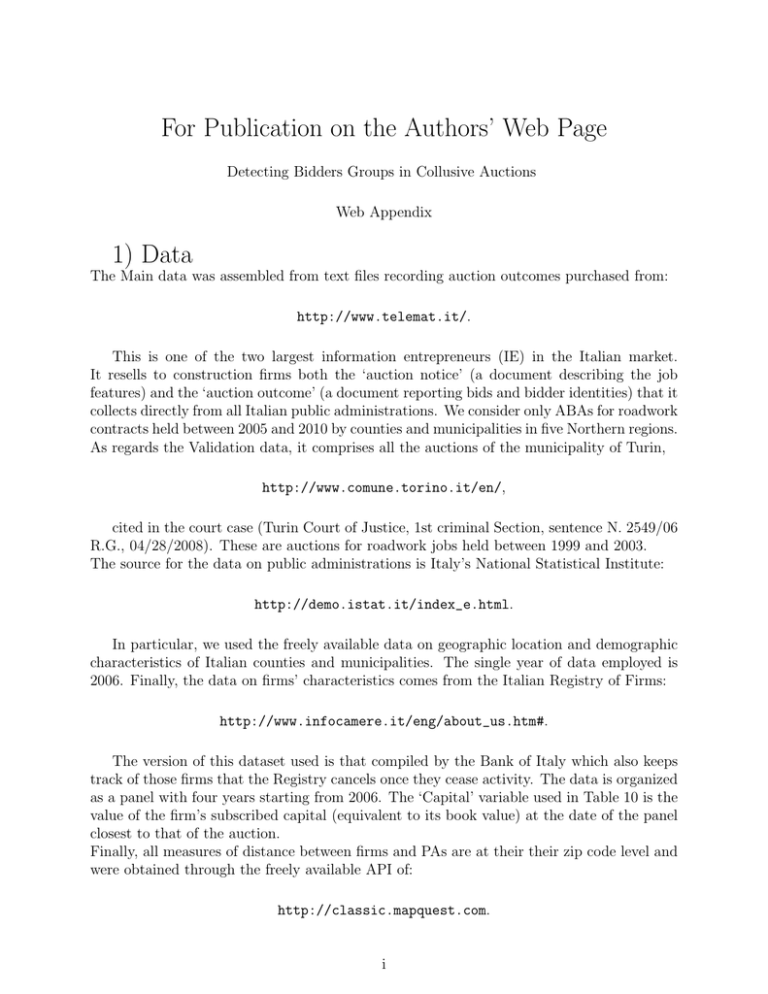
For Publication on the Authors’ Web Page Detecting Bidders Groups in Collusive Auctions Web Appendix 1) Data The Main data was assembled from text files recording auction outcomes purchased from: http://www.telemat.it/. This is one of the two largest information entrepreneurs (IE) in the Italian market. It resells to construction firms both the ‘auction notice’ (a document describing the job features) and the ‘auction outcome’ (a document reporting bids and bidder identities) that it collects directly from all Italian public administrations. We consider only ABAs for roadwork contracts held between 2005 and 2010 by counties and municipalities in five Northern regions. As regards the Validation data, it comprises all the auctions of the municipality of Turin, http://www.comune.torino.it/en/, cited in the court case (Turin Court of Justice, 1st criminal Section, sentence N. 2549/06 R.G., 04/28/2008). These are auctions for roadwork jobs held between 1999 and 2003. The source for the data on public administrations is Italy’s National Statistical Institute: http://demo.istat.it/index_e.html. In particular, we used the freely available data on geographic location and demographic characteristics of Italian counties and municipalities. The single year of data employed is 2006. Finally, the data on firms’ characteristics comes from the Italian Registry of Firms: http://www.infocamere.it/eng/about_us.htm#. The version of this dataset used is that compiled by the Bank of Italy which also keeps track of those firms that the Registry cancels once they cease activity. The data is organized as a panel with four years starting from 2006. The ‘Capital’ variable used in Table 10 is the value of the firm’s subscribed capital (equivalent to its book value) at the date of the panel closest to that of the auction. Finally, all measures of distance between firms and PAs are at their their zip code level and were obtained through the freely available API of: http://classic.mapquest.com. i 2) Bid Test: Details In the paper, Figure 3 shows for cartels B and D the percentile that is used to construct the bid test. Figure A.2 shows these histograms for all the 8 cartels. In the paper, Table 5 reports the median p-value for the two-sided bid test, performed both with and without firm covariates. In this appendix, Table A.1 and TableA.2 report, in addition to the median, the 10th and 90th percentiles. Moreover, they report these statistics for the one-sided left tests too. The difference between these two tables is due to the different type of conditioning: Table A.1 is obtained by conditioning exclusively on participation in the same auctions, while TableA.2 explicitly conditions on firm observable characteristics (see the discussion in the note to Table 5). A detailed explanation of the tables content is reported at the bottom of each table. 3) Robustness We conducted two sets of experiments to assess the performance of the tests in the presence of two types of problems. The first problem concerns the reduced ability of the tests to detect coordination when multiple groups are active. Both the bid and participation tests are less capable of detecting coordination when multiple groups of coordinating firms are active. In fact, since we test for only one group at a time, in this case the reference distribution used to evaluate one group contains both non-coordinating firms and firms belonging to other groups. Therefore, the behavior of the candidate group is less likely to appear as anomalous. The Validation data allows us to explore how severe this problem is by repeating the tests for each of the 8 cartels when firms from the other 7 cartels are excluded from the reference distributions. For the participation test we observe that for 6 out of the 8 cartels the test more forcefully indicates that firms in the cartel jointly participate more than firms in the comparison groups. There is no improvement for the remaining 2 cartels.26 For the bid test we report the results in Table A.3. We observe an improved performance (relative to Table A.1): The minimum number of K-touples needed for detection remains the same for cartels A and H while it decreases for the others. With the one-tail test we now detect group G. However, apart from the improvement observed for cartel G, these results are qualitatively the same as those reported in section 5. The second problem for which we conduct experiments regards how correlation in firms characteristics might cause the tests to indicate coordination even when coordination is absent. If certain firm characteristics induce correlation in firms entry or bidding, then a group of firms sharing those characteristics might test positive for coordination. We explore this issue by conducting two types of experiments. In the first one, for each one of the 8 cartels we generate 100 candidate groups that: i) contain only non-coordinating firms and ii) replicate the cartel structure in terms of firms capitalization, location and legal qualification to bid. Among these 100 replicas, 8% and 9%, respectively for cartels H and G, test positive for the participation test. For all other cartels, this share ranges from 0% to 2%. For the bid test this share is below 5% for the replicas of each of the 8 cartels as long as K-touples of 4 26 More precisely, the 95th percentile of the reference distribution reaches zero earlier than for the cases in Figure 2. For cartel B, it reaches zero at a size of 8 instead of 10. Analogously, for C it is 6 instead of 7, for G it is 7 instead of 9, for A it is 5 instead of 6, for D it is 4 instead of 5 and for H it is 6 instead of 7. ii or more auctions are used. Overall, for these groups that resemble cartels but are composed of non-coordinating firms, the share of wrong detections is close to the 5% criterion we use to detect coordination. In the second experiment, we construct groups composed of firms that are in the top/bottom 2.5% of the distributions of capital and distance from Turin. Thus, the first set of groups is composed of only firms located very close to Turin, the second only by firms very far away from it, the third only by firms with a very low capitalization and the fourth only by firms with a very high capitalization. For every set, we construct 100 groups considering two possible scenarios: In the first, groups contain only non-cartel members, while in the second groups can contain cartel members but no group can contain more than one member of the same cartel. Therefore, all the resulting groups contain firms that are similar along some dimensions, but ideally should not be detected as cartels. As regards the participation test, the fraction of groups detected as cartels is typically 0% for groups of high/low capital and low distance from Turin. However, it rises to about 6% for the case of the most distant firms, suggesting that firms from far away tend to enter the same auctions in Turin. Possibly, these are auctions for particularly valuable contracts or, instead, these firms belong to some cartel that was not convicted by the court in Turin. As regards the bid test, because conditioning on joint participation limits the amount of usable firms, we experimented with fewer groups (50 instead of 100) and only with firms exhibiting the highest capitalization and the lowest distance. These results confirm the good performance of this test which never detects cartels among these candidate groups. 4) Alternative Methods to Testing with Unknown Groups In the paper, Table 7 reports the structure of the 14 groups generated by applying to the Validation data our 3-step method based on a ‘good data scenario’ in which various firm characteristics are observable by the researcher. In this appendix, the note to Table A.5 gives the details on how this method is implemented and presents additional results. Poor Data Scenario: In the paper, we mention a different method tailored to environments in which the dataset contains only the identity and the bid of each participant in each auction. We examine the performance of a method that forms groups based on participation patterns and then applies only our bid test to analyze coordination. Not relying on the participation test is in any case the preferable choice when no firms’ covariates can be used to construct the comparison groups. The strategy has two steps. First, we identify firms that could be acting as a group leader by selecting the 10% of firms with highest participation in the dataset. Second, for each group leader, we construct its group by first pairing it to it the firm with which it participates most often, then associating the resulting 2-firm group with the firm that participates most often with it, and so on until size N is reached. We apply this method to the Validation, imposing a group size of N=6 and selecting as group leaders the top 10% of firms in terms of participation (81 firms). Since some of the resulting groups are identical, we end up with the 56 distinct groups. Table A.6 shows that the method performs poorly as only cartel B is well represented by the constructed groups. In the case of cartels F and H, none of their members appears in any of the groups. iii 5) Example Equilibrium We present below a simple example equilibrium in which a group of firms engages in an average-piloting manner. This example captures the idea of a predictable winning range presented in the text and illustrates the basic method of coordinated behavior that our tests are designed to detect. Consider the same IPV framework presented in the text to discuss the equilibrium of the ABA when all N bids are submitted by different firm. Relative to that case, we will now consider a setting where there are N I non-coordinating bidders and a single group of N g coordinating bidders. Let the discounts of the non-coordinators be denoted by a vector bIf . The support of the elements of bIf is common knowledge and equal to [bf − η, bf ] with bf ∈ (0, 1) with bf > η and η > 0 but small. The proposition below states that there is an ε-equilibrium27 where the group clusters its discounts in the tails of the anticipated discount distribution in order to pilot the trimmed means. Proposition: For any bIf and N I and any small ε > 0, there exists a value N g∗∗ such that if the group size is at least N g∗∗ , there is a mixed strategy ε-equilibrium in which all group discounts are below bf − η. If the group size is less than N g∗∗ , but at least N ∗ (the minimum breaking coalition), there are values of bIf and N I such that for any small ε > 0 an ε-equilibrium exists in which all group discounts are above bf . Proof The first part of the proposition states that given any pair (bIf , N I ) for any any small ε > 0 we can find a value N g∗∗ such that if the size of the group, N g , is N g ≥ N g∗∗ , then there is an ε-equilibrium in which all group’s bids are clustered below bf − η. To see why this is the case, suppose that N g = 9N I . Then consider a strategy profile for the group bids such that: (i) exactly (.1)N bids are equal to zero and (ii) all the remaining bids are extremely close together and randomized in (0, ε). Together this strategy profile and bIf constitute an ε-equilibrium. In fact, the group is winning with probability one and it is doing so at a discount that is less than epsilon above zero. The non-coordinating bidders make a zero profit. However, their expected gain from a deviation can be made arbitrarily small because their probability of winning can be made arbitrarily small. This happens because the location of the interval where the winning bid lies, [A1, A2), is governed exclusively by the group’s bids. Since they are closely clustered together and randomized, the probability that a non-coordinating bidder wins is negligible. Hence, we have shown that for N g = 9N I an ε-equilibrium exists. For any larger N g the same strategy profile is also an ε-equilibrium. This argument implies that N g∗∗ always exists: it is at most equal to 9N I , but it is possibly smaller, depending on the game parameters.28 For the second part of the proposition, we use a constructive proof for a specific bIf . The same logic can then be applied for other bIf . Therefore, consider the bIf such that: (i) a subset 27 In an ε-Nash equilibrium (Radner, R., (1980). “Collusive Behavior in Oligopolies with Long but Finite Lives,” Journal of Economic Theory, 22, 136-156.) no player has a deviation leading to gain more than ε. This is a full information concept and we can apply it because, by focusing on a situation in which the social norm is to center discounts around a known range, we are implicitly assuming that doing so is profitable. 28 For instance, when N = 5, a group of size N g = N 0 = 3 suffices to guarantee that an ε-equilibrium with downward clustering exists. The group places one bid at zero. It clusters its other two bids within a tiny interval of size δ and randomizes them within a small interval (0, ε). An independent trying to win would then need to pace its bid within this 2-bibs cluster of cartel bids. However, by reducing δ the probability of this event can be made arbitrarily small. iv of N 0 non-coordinating firms bids bf − η and (ii) the remaining non-coordinating firms bid bf . Given this bids profile, we start by looking at a group of size N ∗ with bids clustered above bf according to the profile: (i) two bids, bg1 ,and bg2 , such that bg2 = bg1 + δ with a very small δ > 0 and with bgi ∈ [bf , bf + ε], i = 1, 2 with small δ < ε and (ii) the remaining N ∗ − 2 bids all identically equal to some value bh ∈ (bf + ε, 1]. To find the conditions under which this bids profile together with bIf constitutes an ε-equilibrium we proceed in steps. Step 1: First we show when the group’s bids constitute an ε-best response to bIf . Regardless of the exact values of bh and bf , any bg1 > bf implies that the group wins with probability one at a price of bg1 . Could this group do better by bidding bf or less? If the group could place all its bids in (bf − η, bf ) it would again win with probability one and with a better price. However, this gain is bounded by η so that at most the group could gain (bf + ε− δ) − (bf − η) = ε− δ + η. Since the only restriction on ε is ε > 0, by selecting appropriately small δ and η we can make ε small. As regards placing bids below bf − η, placing less than N ∗ of them below bf leads to a zero probability of winning. However, even clustering all bids below (downward clustering) bf − η might never lead to a positive profit if bf is low and N is large relative to the group size. The reason is that a downward clustering strategy is profitable iff A2 6 bf − η, otherwise one of the non-coordinating firms win. However, dragging down A2 cannot be achieved by placing all bids equal to zero: in this case the group minimizes A1 but loses all its influence on A2 which would then be commanded only by the non-coordinating firms bids resulting in the victory of one of them at the price bf − η. To maintain any influence on A2 the group must keep at least one bid strictly greater than A1. We next show that sometimes this is impossible. To simplify the exposition suppose N 0 = .1N . Let’s indicate by bgN ∗ the highest bid that the group submits. Since the first N ∗ − 2 bids are trimmed in the first stage of the ABA algorithm and since among the 2 remaining bids the lowest will always be strictly less than A1, the best the group can do is to place: (i) N ∗ − 1 bids equal to zero and (ii) bgN ∗ ∈ (0, bf − η). However, if such bids profile has to achieve A2 6 bf − η, then it must be that bgN ∗ 6 bf − [N (.7) − 1]η. But since bgN ∗ > A1 requires bgN ∗ > [(N (.8) − 2)bf − N (.1)η]/(N (.8) − 1), then there is no bgN ∗ that can satisfy both conditions at the same time whenever: bf 6 [N (N (.56) − 1.6) + 1]η. Similar conditions to the ones found here for a group of size N ∗ can be derived for larger groups to check if there is a downward clustering strategy achieving at the same time bgN ∗ > A1 and A2 6 bf − η. If that is not the case, then only upward clustering is an ε-best response. But as the coalition size grows, eventually downward clustering will become the sole best response. Step 2: We now show that non-coordinating bidder deviations lead to gains that are bounded by ε. A deviation to a bid below bf loses with probability one and the same is true for any deviation above bf + ε. However, a deviation to a bid b0 ∈ (bf , bf + ε) might be profitable if there is a high enough probability that b0 wins. Nevertheless, it is always possible to arbitrarily shrink the gain of the deviant by increasing the group size: If we increase the group size above N ∗ and place each additional bid equal to bg2 , then, as the group size grows, the probability that the deviant wins goes to zero because the probability that it can outguess the group and place its bid within the narrowly clustered group bids goes to zero. If the group size needed to achieve this is smaller than N g∗∗ and the two conditions above for the incentive to cluster downward (bgN ∗ > A1 and A2 6 bf − η) are not simultaneously satisfied, we have obtained an ε-equilibrium with upward clustering. v Table A.1: Muti-Auction Bid Test with No Firm Covariates (Validation Data) 2 4 6 8 10 2 4 6 8 10 2 4 6 8 10 2 4 6 8 10 Cartel B - size 5 (184 auctions) Two-sided One-sided Left 10th 50th 90th 10th 50th 90th 0.02 0.13 0.47 0.01 0.09 0.43 0.00 0.06 0.20 0.00 0.05 0.19 0.00 0.06 0.19 0.00 0.05 0.16 0.00 0.04 0.13 0.00 0.04 0.13 0.00 0.03 0.09 0.00 0.02 0.08 Cartel G - size 4 (68 auctions) Two-sided One-sided Left th th th 10 50 90 10th 50th 90th 0.03 0.22 0.72 0.02 0.18 0.56 0.03 0.23 0.58 0.04 0.26 0.63 0.03 0.15 0.54 0.06 0.19 0.46 0.04 0.18 0.43 0.07 0.21 0.47 0.04 0.18 0.37 0.09 0.24 0.41 Cartel E - size 5 (20 auctions) Two-sided One-sided Left 10th 50th 90th 10th 50th 90th 0.01 0.11 0.47 0.02 0.23 0.98 0.00 0.08 0.17 0.88 0.97 1.00 0.02 0.05 0.14 0.96 1.00 1.00 0.02 0.06 0.14 0.95 1.00 1.00 0.02 0.05 0.11 1.00 1.00 1.00 Cartel F - size 5 (21 auctions) Two-sided One-sided Left th th th 10 50 90 10th 50th 90th 0.00 0.05 0.45 0.00 0.51 0.88 0.00 0.02 0.22 0.03 0.52 0.92 0.00 0.02 0.10 0.13 0.47 0.87 0.00 0.01 0.06 0.17 0.44 0.82 0.00 0.01 0.04 0.26 0.50 0.79 739 574 354 727 56 728 831 621 455 313 190 466 615 427 66 199 822 938 972 984 Cartel C - size 5 (51 auctions) Two-sided One-sided Left 10th 50th 90th 10th 50th 90th 0.03 0.11 0.38 0.02 0.08 0.33 0.01 0.06 0.20 0.01 0.07 0.36 0.01 0.03 0.14 0.01 0.05 0.26 0.00 0.01 0.04 0.00 0.03 0.16 0.00 0.01 0.03 0.00 0.02 0.12 Group A - size 7 (10 auctions) Two-sided One-sided Left th th th 10 50 90 10th 50th 90th 0.00 0.00 0.04 0.98 1.00 1.00 0.00 0.00 0.02 0.98 1.00 1.00 0.00 0.00 0.02 0.99 1.00 1.00 0.00 0.00 0.02 0.99 1.00 1.00 Cartel D - size 4 (19 auctions) Two-sided One-sided Left 10th 50th 90th 10th 50th 90th 0.20 0.43 0.64 0.39 0.75 0.98 0.17 0.39 0.63 0.60 0.83 0.99 0.21 0.39 0.56 0.70 0.84 0.98 0.26 0.38 0.52 0.73 0.84 0.96 0.27 0.40 0.53 0.76 0.85 1.00 Cartel H - size 5 (25 auctions) Two-sided One-sided Left th th th 10 50 90 10th 50th 90th 0.00 0.04 0.32 0.82 0.97 1.00 0.00 0.03 0.12 0.89 0.97 1.00 0.00 0.02 0.09 0.95 0.98 1.00 0.00 0.01 0.04 0.95 0.99 1.00 0.00 0.01 0.04 0.96 0.99 1.00 531 399 311 278 209 45 206 207 45 160 482 280 127 40 289 965 997 999 999 Table A.1 shows the distribution of the result of the bid test for subgroups of the eight groups of the Validation data. The table reports the size of the subgroup and the number of auctions in which the firms in the chosen subgroup jointly participated. The leftmost column indicates whether the test was conducted looking at a pair, triplet, quadruplet, etc. of auctions. The next three columns report three percentiles (10th , 50th and 90th ) of the distribution of the two-sided version of the test. The following three columns report the same information for the one-sided (left) version of the test. All numbers should be read as p-values of a test with a null stating that the group analyzed is not different from the comparison groups. The distribution of the test’s results is reported because there is a multiplicity of pairs, triplets, quadruplets, etc. for which the test can be conducted. The number of these pairs, triplets, quadruplets, etc. used is reported in the eighth column. In all these pairs, triplets, etc. of auctions, we observe at least 30 firms in common and, hence, that allows the construction of a large number of random groups. vi Table A.2: Muti-Auction Bid Test with Firm Covariates (Validation Data) 2 4 6 8 10 2 4 6 8 10 2 4 6 8 10 2 4 6 8 10 Cartel B - size 5 (184 auctions) Two-sided One-sided Left 10th 50th 90th 10th 50th 90th 0.02 0.11 0.49 0.01 0.10 0.42 0.01 0.10 0.41 0.01 0.08 0.32 0.00 0.09 0.26 0.00 0.08 0.25 0.00 0.07 0.20 0.00 0.05 0.19 0.02 0.09 0.15 0.02 0.05 0.14 Cartel G - size 4 (68 auctions) Two-sided One-sided Left th th th 10 50 90 10th 50th 90th 0.04 0.36 0.94 0.03 0.14 0.51 0.03 0.16 0.59 0.02 0.07 0.20 0.04 0.19 0.59 0.03 0.08 0.19 0.02 0.11 0.33 0.01 0.05 0.14 0.03 0.09 0.34 0.02 0.06 0.13 Cartel E - size 5 (20 auctions) Two-sided One-sided Left 10th 50th 90th 10th 50th 90th 0.01 0.09 0.31 0.29 0.94 1.00 0.00 0.05 0.18 0.71 0.99 1.00 0.00 0.02 0.11 0.94 1.00 1.00 0.00 0.02 0.08 0.99 1.00 1.00 0.00 0.02 0.04 0.99 1.00 1.00 Cartel F - size 5 (21 auctions) Two-sided One-sided Left th th th 10 50 90 10th 50th 90th 0.00 0.07 0.39 0.00 0.56 0.87 0.00 0.03 0.13 0.11 0.51 0.96 0.00 0.02 0.11 0.13 0.53 0.93 0.00 0.01 0.04 0.15 0.46 0.85 0.00 0.00 0.03 0.30 0.54 0.76 815 859 902 445 45 992 981 992 989 982 190 177 119 39 1 210 761 902 956 984 Cartel C - size 5 (51 auctions) Two-sided One-sided Left 10th 50th 90th 10th 50th 90th 0.02 0.11 0.32 0.02 0.10 0.46 0.02 0.09 0.37 0.02 0.10 0.57 0.02 0.08 0.35 0.03 0.10 0.50 0.01 0.07 0.32 0.03 0.14 0.40 0.01 0.07 0.32 0.02 0.09 0.41 Group A - size 7 (10 auctions) Two-sided One-sided Left th th th 10 50 90 10th 50th 90th 0.00 0.00 0.04 0.97 0.99 1.00 0.00 0.02 0.05 0.95 0.98 1.00 0.00 0.02 0.05 0.95 0.98 1.00 0.00 0.02 0.04 0.96 0.98 1.00 Cartel D - size 4 (19 auctions) Two-sided One-sided Left 10th 50th 90th 10th 50th 90th 0.22 0.41 0.69 0.51 0.78 1.00 0.18 0.37 0.65 0.55 0.84 1.00 0.20 0.41 0.55 0.73 0.86 0.98 0.23 0.40 0.51 0.75 0.90 0.99 0.21 0.35 0.48 0.79 0.92 0.97 Cartel H - size 5 (25 auctions) Two-sided One-sided Left th th th 10 50 90 10th 50th 90th 0.00 0.04 0.29 0.83 0.97 1.00 0.01 0.04 0.20 0.76 0.96 1.00 0.00 0.03 0.12 0.82 0.97 1.00 0.01 0.03 0.08 0.86 0.96 0.99 0.01 0.03 0.08 0.90 0.97 1.00 608 610 628 676 663 45 206 207 45 134 67 15 3 3 300 965 997 999 999 Table A.2 has the same structure as Table A.1. The only difference is that the results reported in this table are obtained with comparison groups that are generated to match the suspect cartel in terms of observable firm characteristics. As described in the paper, these groups are constructed using firms legal qualifications to bid, capital and distance to the place of the work. vii Table A.3: Muti-Auction Bid Test Results - Non-coordinators as Controls (Validation Data) 2 4 6 8 10 2 4 6 8 10 2 4 6 8 10 2 4 6 8 10 Cartel B - size 5 (184 auctions) Cartel C - size 5 (51 auctions) Two-sided One-sided Left Two-sided One-sided Left 10th 50th 90th 10th 50th 90th 10th 50th 90th 10th 50th 90th 0.01 0.13 0.43 0.00 0.02 0.07 625 0.02 0.10 0.47 0.00 0.00 0.06 0.00 0.07 0.27 0.00 0.00 0.04 318 0.00 0.04 0.12 0.00 0.00 0.03 0.00 0.03 0.11 0.00 0.00 0.04 158 0.00 0.02 0.08 0.00 0.00 0.00 0.00 0.02 0.12 0.00 0.00 0.04 31 0.00 0.02 0.05 0.00 0.00 0.00 0.00 0.02 0.06 0.00 0.00 0.00 Cartel G - size 4 (68 auctions) Cartel A - size 7 (10 auctions) Two-sided One-sided Left Two-sided One-sided Left th th th th th th th th th 10 50 90 10 50 90 10 50 90 10th 50th 90th 0.05 0.32 0.82 0.00 0.08 0.71 676 0.00 0.00 0.03 0.96 0.99 1.00 0.01 0.20 0.77 0.00 0.05 0.43 464 0.00 0.00 0.02 0.98 1.00 1.00 0.03 0.21 0.74 0.00 0.06 0.45 200 0.00 0.00 0.02 0.98 1.00 1.00 0.01 0.14 0.51 0.00 0.04 0.26 105 0.00 0.00 0.02 0.98 1.00 1.00 0.02 0.12 0.40 0.00 0.04 0.17 48 Cartel E - size 5 (20 auctions) Cartel D - size 4 (19 auctions) Two-sided One-sided Left Two-sided One-sided Left 10th 50th 90th 10th 50th 90th 10th 50th 90th 10th 50th 90th 0.02 0.12 0.42 0.28 0.95 1.00 94 0.23 0.50 0.70 0.08 0.50 1.00 0.00 0.10 0.26 0.87 0.97 1.00 468 0.22 0.46 0.69 0.11 0.59 1.00 0.00 0.03 0.16 0.95 1.00 1.00 623 0.21 0.43 0.60 0.27 0.68 0.93 0.00 0.02 0.14 1.00 1.00 1.00 428 0.25 0.41 0.56 0.30 0.64 0.98 0.00 0.00 0.08 1.00 1.00 1.00 63 0.28 0.39 0.50 0.34 0.64 0.89 Cartel F - size 5 (21 auctions) Cartel H - size 5 (25 auctions) Two-sided One-sided Left Two-sided One-sided Left th th th th th th th th th 10 50 90 10 50 90 10 50 90 10th 50th 90th 0.00 0.07 0.44 0.00 0.43 0.80 169 0.00 0.05 0.36 0.61 0.96 1.00 0.00 0.03 0.27 0.00 0.37 0.98 766 0.00 0.04 0.18 0.74 0.95 0.99 0.00 0.02 0.13 0.05 0.32 0.91 875 0.00 0.02 0.11 0.83 0.95 1.00 0.00 0.02 0.09 0.12 0.46 0.89 891 0.00 0.03 0.08 0.88 0.96 1.00 0.00 0.02 0.07 0.18 0.48 0.79 886 0.00 0.03 0.06 0.88 0.96 1.00 407 212 102 74 42 45 206 207 45 114 451 265 120 31 288 943 946 910 949 Table A.3 has the same structure as Table A.1. As in Table A.1, the comparison groups are constructed without explicitly conditioning on firm observable characteristics. The only difference relative to that table is that here the comparison groups used to test the 8 cartels of the Validation data are constructed using exclusively firms outside the list of 95 suspect firms. For most of the cartels this implies that we achieve detection with a smaller touple of auctions (using the median of the two-sided test results) relative to Table A.1, but also that less auctions have enough noncoordinating bidders to be usable in the analysis. viii Table A.4: Muti-Auction Bid Test Results - Clusters in the Main Data 2 4 6 8 2 4 6 8 2 4 6 8 Cluster 1 - size 5 (63 auctions) Two-sided One-sided Left 10th 50th 90th 10th 50th 90th 0.00 0.08 0.29 0.00 0.21 0.86 0.00 0.03 0.16 0.00 0.05 0.46 0.00 0.03 0.16 0.00 0.02 0.36 0.00 0.03 0.15 0.00 0.05 0.43 Cluster 3 - size 9 (95 auctions) Two-sided One-sided Left th th th 10 50 90 10th 50th 90th 0.00 0.02 0.57 0.06 0.49 0.97 0.00 0.02 0.27 0.12 0.33 0.94 0.00 0.02 0.10 0.44 0.45 0.80 Cluster 5 - size 4 (75 auctions) Two-sided One-sided Left 10th 50th 90th 10th 50th 90th 0.05 0.20 0.65 0.01 0.08 0.44 0.04 0.15 0.53 0.02 0.06 0.34 0.03 0.15 0.39 0.02 0.06 0.29 0.04 0.11 0.31 0.00 0.05 0.23 808 999 254 502 999 999 552 Cluster 2 - size 5 (83 auctions) Two-sided One-sided Left 10th 50th 90th 10th 50th 90th 0.00 0.09 0.68 0.00 0.36 0.89 0.00 0.06 0.48 0.02 0.36 0.91 0.01 0.09 0.38 0.13 0.58 0.93 0.00 0.05 0.27 0.25 0.61 0.92 Cluster 4 - size 5 (52 auctions) Two-sided One-sided Left th th th 10 50 90 10th 50th 90th 0.00 0.13 0.58 0.00 0.20 0.89 0.00 0.08 0.33 0.00 0.20 0.69 0.00 0.05 0.40 0.00 0.16 0.38 0.00 0.05 0.21 0.00 0.04 0.08 987 999 165 414 499 499 499 36 999 999 999 999 Table A.4 shows the distribution of the results of the bid test for the 5 clusters of the Main data for which this test detects coordination. The table has the same structure as Table A.1. See the note to that table for the description of the table content. As in Table A.1, the comparison groups are constructed without explicitly conditioning on firm observable characteristics. ix Table A.5: Constructing Clusters in the Validation Data (95 Suspect Firms) Assigned Group 1 2 3 4 5 6 7 8 9 10 11 12 13 14 15 16 17 p̂ 0.45 0.1 0.3 0.15 0.25 0.55 0.25 0.15 0.1 0.15 0 0 0 0 0 0.1 0 Variable p̂ Known Group Auctions Cartel Member Won E (8,0,1) 5 A (2,0,6) 3 H (7,0,2) 1 G (5,0,1) 13 C (4,0,4) 20 B (8,0,0) 66 C (3,1,1) 19 D (3,1,5) 11 F (2,1,7) 4 G (2,1,4) 2 H (1,0,6) 3 A (1,1,8) 7 G (2,0,8) 2 C (1,0,8) 4 C (1,2,3) 3 H (1,0,7) 0 H (1,0,7) 3 Detect Bid No Both No Both Bid Bid Bid Part Both No No No No Part No Part p̂ = 0.2 Known Group Auctions Cartel Member Won E (10,1,7) 8 A (2,0,4) 2 H (8,0,3) 1 G (5,0,1) 13 C (7,0,6) 25 B (11,4,8) 85 C (3,2,10) 21 D (3,1,5) 11 F (2,0,4) 4 G (2,1,3) 2 Detect Bid No Both No Both Bid No No Both Both The clusters shown in the table are obtained under the ‘good data scenario’ with slight modifications of the 3-step procedure used for the clusters in Table 7.* We report these additional results for their comparison with those in Table 7. The right panel is the analogue of Table 7 with the only difference that the leaders list used to construct the network of connected firms is not the top 10% participants in the Validation data but the official list of suspect firms. Notice that, relative to Table 7 we get only 10 clusters, instead of 14, and that they match more precisely the cartels. As in Table 7, the first column of the right panel reports the identity of the most represented cartel. Next, the triplet in the parenthesis reports the number of members of this cartel, the number of members of all other cartels and the number of non-coordinating firms. The last two columns report the number of victories and whether the cluster is detected as a group of coordinating firms by our bid test (Bid), participation test (Part.), both of them (Both) or it is not detected (None). Detection is defined as in Table 7. The left panel is analogous to the right panel with the only exception that to get the final assignment to clusters, we do not impose a fixed cutoff which excludes firms that have a predicted probability of being together in a cartel below 20% (i.e., p̂ = 0.2), as done in the right panel and in Table 7. Instead, we impose that the assigned group has at most a size equal to 10 and so, whenever the clustering algorithm returns a cluster larger than 10, we trim it by increasing the p̂ until the size is no greater than 10. The first column in the left panel reports the p̂ we used to trim each cluster. *) Additional details on how the clusters in Table 7 were obtained: (1) Step 1 of our 3-step procedure estimates the probit using 7 cartels, excluding cartel D (the cartel not convicted for systematic repetition of collusive behavior; results are nearly identical including this cartel); (2) Step 3 uses the default hierarchical clustering algorithm of Stata (cluster) using the average distance between clusters as the aggregation criterion and a cutoff (cutt) of .997; (3) to refine the clusters, we pick the most connected firms (using a fixed p̂ = 0.2); (4) we test the validity of the groups using the Monte Carlo approach described in chapter 7 of Gordon (1999) rejecting that the clusters are identical to random groups of firms at a 5%. x Table A.6: Assigned Groups - Validation Data Cartel B C G A E D F H - Poor Data Scenario No. of Groups Avg. No. Cartel Firms 13 4.53 (out of 6) 8 2.37 (out of 6) 5 1.20 (out of 6) 3 1.00 (out of 6) 3 1.30 (out of 6) 3 1.00 (out of 6) 0 0.00 (out of 6) 0 0.00 (out of 6) 21 - The first column of the table reports the cartel, if any, to which the group leader belongs. The second column reports how many groups have the group-head belonging to this cartel. The last column reports the average number of firms across these 6-firm groups that belong to the same cartel of the group-head. None of the group-heads belongs to cartels F and H. Figure A.1: Localization of the 8 Cartels Location of the headquarters of the firms in the 8 cartels of the Validations data. The letters from A to H indicate the different cartels. The small map of Italy shows that 6 cartels are located in the Northwest, one in the Northeast and one in the Center-South. The large map shows the location of the 6 cartels in the Northwest, which are all based within 50 kilometers from Turin/Torino. xi Figure A.2: Cartel Bids Impact on the trimmed mean - Validation Data (a) Cartel B (b) Cartel C Bid Test − Number of Cartel Members: 18 Bid Test − Number of Cartel Members: 13 140 90 80 120 70 100 60 80 50 40 60 30 40 20 20 10 0 0 10 20 30 40 50 60 70 80 90 100 0 0 10 (c) Cartel G 40 16 35 14 30 12 25 10 20 8 15 6 10 4 5 2 10 20 30 40 50 60 70 80 40 50 60 70 80 90 100 80 90 100 80 90 100 90 100 Bid Test − Number of Cartel Members: 12 18 0 30 (d) Cartel A Bid Test − Number of Cartel Members: 20 45 0 20 90 100 0 0 10 20 (e) Cartel E 30 40 50 60 70 (f) Cartel D Bid Test − Number of Cartel Members: 11 Bid Test − Number of Cartel Members: 7 70 6 60 5 50 4 40 3 30 2 20 1 10 0 0 10 20 30 40 50 60 70 80 90 100 0 0 10 (g) Cartel F 20 30 40 50 60 70 (h) Cartel H Bid Test − Number of Cartel Members: 8 Bid Test − Number of Cartel Members: 14 18 30 16 25 14 12 20 10 15 8 6 10 4 5 2 0 0 10 20 30 40 50 60 70 See the note to Figure 3. 80 90 100 0 0 xii 10 20 30 40 50 60 70 80
